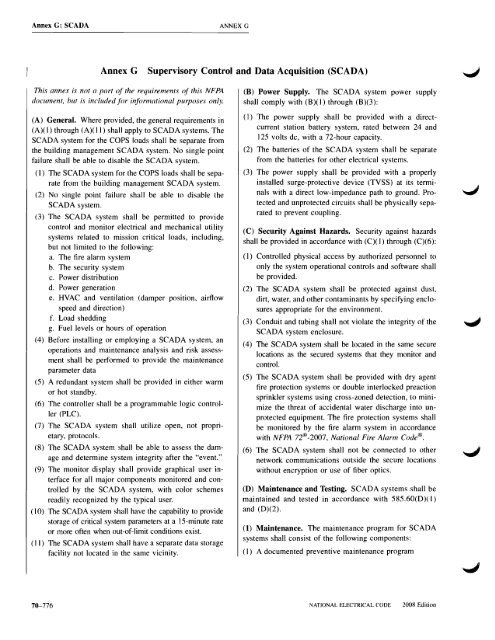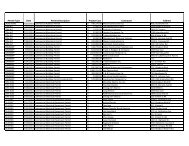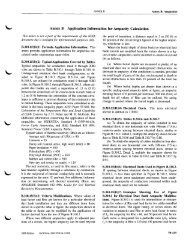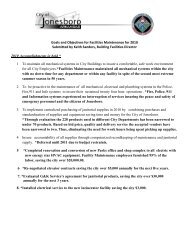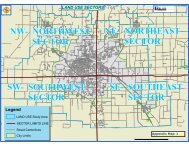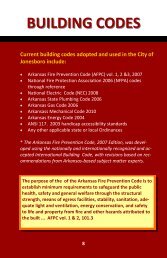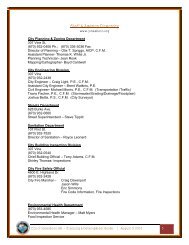Annex G Supervisory Control and Data Acquisition (SCADA)
Annex G Supervisory Control and Data Acquisition (SCADA)
Annex G Supervisory Control and Data Acquisition (SCADA)
You also want an ePaper? Increase the reach of your titles
YUMPU automatically turns print PDFs into web optimized ePapers that Google loves.
<strong>Annex</strong> G: <strong>SCADA</strong><br />
ANNEX G<br />
<strong>Annex</strong> G<br />
<strong>Supervisory</strong> <strong>Control</strong> <strong>and</strong> <strong>Data</strong> <strong>Acquisition</strong> (<strong>SCADA</strong>)<br />
This annex is not a part of the requirements of this NFPA<br />
document, but is included for informational purposes only.<br />
(A) General. Where provided. the general requirements in<br />
(A)( I) through (A)( II) shall apply to <strong>SCADA</strong> systems. The<br />
<strong>SCADA</strong> system for the COPS loads shall be separate from<br />
the building management <strong>SCADA</strong> system. No single point<br />
failure shall be able to disable the <strong>SCADA</strong> system.<br />
(I) The <strong>SCADA</strong> system for the COPS loads shall be separate<br />
from the building management <strong>SCADA</strong> system.<br />
(2) No single point failure shall be able to disable the<br />
<strong>SCADA</strong> system.<br />
(3) The <strong>SCADA</strong> system shall be permitted to provide<br />
control <strong>and</strong> monitor electrical <strong>and</strong> mechanical utility<br />
systems related to mission critical loads, including,<br />
but not limited to the following:<br />
a. The fire alarm system<br />
b. The security system<br />
c. Power distribution<br />
d. Power generation<br />
e. HVAC <strong>and</strong> ventilation (damper position, airflow<br />
speed <strong>and</strong> direction)<br />
f. Load shedding<br />
g. Fuel levels or hours of operation<br />
(4) Before installing or employing a <strong>SCADA</strong> system, an<br />
operations <strong>and</strong> maintenance analysis <strong>and</strong> risk assessment<br />
shall be performed to provide the maintenance<br />
parameter data<br />
(5) A redundant system shall be provided in either warm<br />
or hot st<strong>and</strong>by.<br />
(6) The controller shall be a programmable logic controller<br />
(PLC).<br />
(7) The <strong>SCADA</strong> system shall utilize open, not proprietary,<br />
protocols.<br />
(8) The <strong>SCADA</strong> system shall be able to assess the damage<br />
<strong>and</strong> determine system integrity after the "event."<br />
(9) The monitor display shall provide graphical user interface<br />
for all major components monitored <strong>and</strong> controlled<br />
by the <strong>SCADA</strong> system, with color schemes<br />
readily recognized by the typical user.<br />
(10) The <strong>SCADA</strong> system shall have the capability to provide<br />
storage of critical system parameters at a 15-minute rate<br />
or more often when out-of-limit conditions exist.<br />
(11) The <strong>SCADA</strong> system shall have a separate data storage<br />
facility not located in the same vicinity.<br />
(B) Power Supply. The <strong>SCADA</strong> system power supply<br />
shall comply with (B)(I) through (B)(3):<br />
(I) The power supply shall be provided with a directcurrent<br />
station battery system, rated between 24 <strong>and</strong><br />
125 volts dc, with a 72-hour capacity.<br />
(2) The batteries of the <strong>SCADA</strong> system shall be separate<br />
from the batteries for other electrical systems.<br />
(3) The power supply shall be provided with a properly<br />
installed surge-protective device (TVSS) at its terminals<br />
with a direct low-impedance path to ground. Protected<br />
<strong>and</strong> unprotected circuits shall be physically separated<br />
to prevent coupling.<br />
(C) Security Against Hazards. Security against hazards<br />
shall be provided in accordance with (C)( I) through (C)(6):<br />
(I) <strong>Control</strong>led physical access by authorized personnel to<br />
only the system operational controls <strong>and</strong> software shall<br />
be provided.<br />
(2) The <strong>SCADA</strong> system shall be protected against dust.<br />
dirt, water, <strong>and</strong> other contaminants by specifying enclosures<br />
appropriate for the environment.<br />
(3) Conduit <strong>and</strong> tubing shall not violate the integrity of the<br />
<strong>SCADA</strong> system enclosure.<br />
(4) The <strong>SCADA</strong> system shall be located in the same secure<br />
locations as the secured systems that they monitor <strong>and</strong><br />
control.<br />
(5) The <strong>SCADA</strong> system shall be provided with dry agent<br />
fire protection systems or double interlocked preaction<br />
sprinkler systems using cross-zoned detection, to minimize<br />
the threat of accidental water discharge into unprotected<br />
equipment. The fire protection systems shall<br />
be monitored by the fire alarm system in accordance<br />
with NFPA 72®-2007, National Fire Alarm Code®.<br />
(6) The <strong>SCADA</strong> system shall not be connected to other<br />
network communications outside the secure locations<br />
without encryption or use of fiber optics.<br />
(D) Maintenance <strong>and</strong> Testing. <strong>SCADA</strong> systems shall be<br />
maintained <strong>and</strong> tested in accordance with 585.60(D)( I)<br />
<strong>and</strong> (D)(2).<br />
(1) Maint~nance. The maintenance program for <strong>SCADA</strong><br />
systems shall consist of the following components:<br />
(I) A documented preventive maintenance program<br />
70-776<br />
NATIONAL ELECTRICAL CODE<br />
2008 Edition
ANNEX G<br />
<strong>Annex</strong> G: <strong>SCADA</strong><br />
(2) Concurrent maintenance capabilities, to allow the testing,<br />
troubleshooting, repair, <strong>and</strong>/or replacement of a<br />
component or subsystem while redundant component(s)<br />
or subsystem(s) are serving the load<br />
(3) Retention of operational data - the deleted material<br />
goes well beyond requirements to ensure proper maintenance<br />
<strong>and</strong> operation<br />
(2) Testing. <strong>SCADA</strong> systems shall be tested periodically<br />
under actual or simulated contingency conditions.<br />
FPN No.1: Periodic system testing procedures can duplicate<br />
or be derived from the recommended functional performance<br />
testing procedures of individual components, as<br />
provided by the manufacturers.<br />
FPN No.2: For more information on maintenance <strong>and</strong> testing<br />
of <strong>SCADA</strong>, see NFPA 70B-2006, Recommended Practice<br />
for Electrical Equipment Maintenance.<br />
2008 Edition NATIONAL ELECTRICAL CODE 76-777


